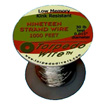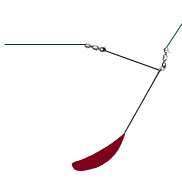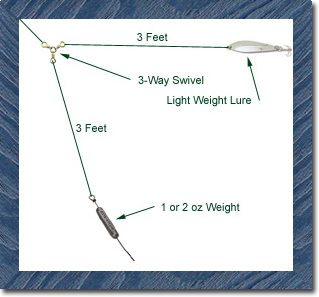Most people never fish for Lake Trout because they think of Lake Trout as this mysterious fish that lives in the unreachable depths of the lake. In actual fact Lake Trout are a ton of fun to catch, taste great and are very easy to catch with the right techniques, tactics and equipment.
When choosing the right technique you need to examine the size and structure of the lake as well as the time of year.
Early Spring: In the spring from ice-out to the second or third week after, depending on the weather, most Lake Trout are shallow. The trout will usually be just under the surface to about 15 feet deep. Trolling or casting with trout spoons such as Little Cleos, small Daredevles and Mepps Cyclops is the easiest way to catch them. You can also use deep running Rapalas and other similar lures and troll for them. It's best to cast out sideways and let the boat drag the line straight because the motor may scare the trout out to the sides on a calm day. Most trout that are feeding will be within 50 yards of shore or structure. One good place to cast your lure is the dark water just off a sandbar. In the spring water over top of a sandbar warms up quickly and attracts minnows. The Lake Trout will sit right off the sand bars in the dark water and wait for minnows coming and going.
Summer: In the summer the Lake Trout will be down deeper. In big inland lakes the Lake Trout will be down deep and just above the thermocline, which is usually around 50 feet deep. There may be Lake Trout below the thermocline but oxygen levels are much lower and the trout go into a non-active state almost like they are hibernating. In small spring-fed lakes the Lake Trout might be at all depths. In the morning and evening they may be close to the surface but generally go at least 30 feet deep on a bright sunny day.
If you know the lake well and know the hotspots where the Lake Trout are concentrated, you can just grab your Walleye rod and fish straight down with a jig. Lake Trout tend to favor feathered jigs like the old style Marabou Jigs. It's best to tip them with a worm, minnow or a strip of sucker meat or chub meat. Many people claim that slicing beef or chicken liver into worm-like strips works great. Using rubbers or twistertails does not seem to be effective with Lake Trout although salted baits do work on some lakes.
If you are fishing a huge lake and the Lake Trout are spread out all over the lake then all the techniques below will work, even though some are not effective. If you are fishing a small lake or want to hug the shoreline contour and stay right off drop-offs at a certain depth and you do not know here the hotspots are then covering water and finding the hotspots is more effective using the 3-way swivel rig, which is described below. It's great for fishing out of small motor boats and canoes. Below we describe the pros and cons of different popular methods.
Comparing Different Methods for Fishing Deep for Lake Trout:
 |
Steel Wire:
In the old days, people trolled using steel wire and heavy tuna rods to fish for Lake Trout. Even though people still use this technique, it's actually the least effective way to catch them and it's not very enjoyable. You have to let out excessive amount of line, you have to keep jerking the line and lure and when you do have a fish on, it feels like you have an old boot on the line. As far as effectiveness and level of enjoyment, using steel line is not fun. However people still catch Lake Trout this way and enjoy the hands-on roll.
|
 |
Downriggers:
Downriggers are very effective at dropping your line down to the exact depth you want. They are good for big charter boats that cannot troll slow and have multiple people fishing. Everything else about downriggers is negative. Using downriggers can be very boring. You are not really fishing; you are just driving around until you have a fish on. You can't feel the fishing hit your lure, you can't set the hook when the fish bites and if you are in a big boat with multiple lines out, the boat has to keep moving so all the lines don't get tangled. As a result you are just horsing the fish in and not enjoying the fight. Also, downriggers are great for open-water suspended fish like when you are fishing on the Great Lakes but downriggers are not practical in a small lake where the fish are right on bottom and the bottom depth is constantly changing. With an iron ball screaming through the water, you spook most of the fish you pass.
|
 |
Dipsy Divers:
Dipsy Divers are small and fit in your tack box. They get your line down deep and when the fish hits your lure, the clips release so you are bringing in the fish free-line and can feel the fish fighting. The downfall of Dipsy Divers is it's hard to know how deep you are and there is so much drag on your line while you are trolling, you have to use heavier line and a heavier fishing rod. With Dipsy Divers, when the diver hits bottom, so does your lure thus you lose more lures on snags. The Diver itself can scare fish away. It's much better than steel wire and more fun to use than downriggers but it's not the best way.
|
 |
Bait Walkers & Bottom Bouncers:
Bait Walkers & Bottom Bouncers work. They fit in your tackle box and you can troll as deep as 70 feet with a 2 oz. They are inexpensive and in small lakes you can troll right along the bottom and quickly reel in or lower you line deeper. The only downfall is your lure is only a couple of inches above the sinker so you tend to get a lot more snags. You also have a 2 oz weight between the lure and your fishing rod. As a result, there is a lot more stress on the line between the lure and the sinker and the line can break, especially in the Lake Trout starts rolling. The weight also takes away some of the fight, which is especially true with smaller tout. This is a very effective way of Lake Trout fishing but not the best way.
|
The 3-Way Swivel Technique is Best for Slow Trolling Boats:
The 3-way swivel technique below is ten times better then using steel line and it's a lot more fun then using down-riggers. It's really just a modification to the Bait Walker design. It's effective with any deep fish. It can be used for deep Lake Trout, Rainbow Trout or even Salmon and Steelhead on the Great Lakes. It's also effective for Book Trout in lakes but generally in the middle of the summer, Brook Trout stay in the 15 to 35 foot range while other trout will be feeding 50 to 60 feed down. You can also use this method with Walleye. The big trophy female Walleyes will go deep in the summer. Use this method in 20 to 25 feet of water with a worm harness and hit those big trophy Walleyes.
You need a light action rod with 6 or 8-pound test line. You can also use the ultra-thin braided lines. You also need three-way swivels and a 1 or 2-oz weight depending how deep you want to fish, which depends on what time of year it is.
|
Diagram showing the setup:
By using light line, the line has less friction with the water and slices through so that your line goes down to the bottom without having lots of line out. Tie two 3-foot pieces of line to your three-way swivel. Use a 1 or 2-oz. weight on one line and a light lure on the other. Lake Trout like small lures more than big lures. The very best lure is a small Sutton Silver Spoon. You can also use #1 or #0 Mepps, Panther Martins or Blue Foxes. Small Cleos or a small Mepps Cyclopes are also good.
For Walleye, fish 15 to 25 feet deep and use a worm harness with a big fat worm. You can also use light spinners with a long worm hook or small floating Rapalas and Junior Thundersticks.
|

|
A 1-oz weight with 6-pound test dark green line is good for fishing down to 40 feet. A 2-oz weight is good for fishing down to 65 feet.
Trolling Slow:
You only want to move just fast enough for your lure to work and no faster. If your boat is moving too fast, it will be very hard to find the bottom of the lake. If you are using a boat with a bigger motor and it's hard to keep slow, try back trolling.
Finding the bottom:
The most important aspect of deep water trout fishing is letting out line to get to the bottom. DO NOT JUST LET YOUR LINE OUT UNTIL IT HITS BOTTOM. Hold the rod in one hand with the bail open. Let the line run through the palm of your other hand and grip the line. Once the boat starts moving and you have a good straight troll going, open your hand with the line then close it again. This way you can let out a foot or two of line at a time. Get a rhythm going. Open, close, open, close. Your rod tip will bounce up and down as you release little bits of line. The rhythm of your rod tip bouncing will be disrupted when your weight hits the bottom of the lake. When this happens, reel up a foot or two. The purpose of this procedure is to keep your 3-way swivel setup from getting tangled.
Trout are funny when it comes to hitting your lure. Small ones will hit and then take off so you know you have a fish on. The really big trout will hit the lure and slowly swim away. Some are so big they don't know they're hooked. So if you get a snag, make sure it's not a fish before you start toughing on your line. If it's a big trout, loosen the drag on your reel because they will go nuts and strip a 100 feet of line off your reel before you can turn them. Keep your drag set for 6-pound test line and do not horse the fish in.
Weather:
In the summer time, Lake Trout hit best in the morning between first light and 10:30 AM. They will hit better if the surface of the water is dead calm and it's a clear sky with high pressure. Any other conditions will cause them to slow down. If it's early spring, the trout seem to feed in other parts of the day. In some lakes the trout feed aggressively before dark.
Structure and Wind:
Take a close look at the structure of the shoreline and try to extend the elevation patterns into the lake. If you see a cliff, odds are the water is deep at its face. If you see a string of islands, odds are there is a shallow shoal that runs between them. Trout like drop-offs so you would want to troll parallel to the string of shoals and not over them.
When you drop your line to the bottom, count how many times you let out line. You can get a good estimate of the depth. For Lake Trout, try to stay in 30 to 60 feet and close to shore. If you come across a spot and catch a trout, odds are there are more of them there.
The wind is very important when trout fishing. Traditionally for warm water fish like Walleye or Pike, you would fish on the side of the lake were the wind is blowing. The logic being that the fish follow the surface food that is being blown in. With trout it's the exact opposite. The wind also blows the warm surface water, which does not hold enough oxygen for the trout. Thus fish the side of the lake where the wind is coming from.
There will be Lake Trout out in the middle of the lake suspended about 40 to 60-feet down. They are usually in close proximity to schools of bait-fish. If you are closer to shore in 40 to 60-feet of water and not catching anything, drop your line down to the bottom so you know how deep you are and then leave your rig at that depth and head out into the open water. In the open water, you will usually catch less trout but they will be bigger. This is not always true. There are occasions where all the trout are out in the open water, especially when the last few days have been hot with a strong wind that keeps changing direction.
Depth:
In the Spring, the Lake Trout will be right up to the surface. As the water starts to warm up with the changing weather, the trout start to go deeper. Here is the approximate depth for different times of year. This is not true for all lakes. Some smaller spring fed lakes will have trout shallow all year.
Just after ice-out --> Between 10 feet and the surface
Mid Spring --> About 20 to 30 feet deep
Late Spring --> About 30 to 45 feet deep
Summer --> Summer is the tricky part. Many believe that the Lake Trout go to the deepest part of the lake and stay dormant. In actual fact, the Lake Trout stay suspended in 53° thermal layers or concentrate in shallower holes where a natural spring pumps cold water into the lake. Why are they there? That's where all the baitfish are. There will be trout deeper then 60 feet or on the bottom in the deepest part of the lake but they are not feeding. When they do feed, they come shallower.
Depth Finder:
It's good to have a depth finder so you can map the schools of bait-fish that are suspended. When you do come across a school, troll around the outside of the school. The Lake Trout sit right underneath the school waiting for weak or injured fish to venture outside the school. Out in the middle of the lake, you will find these schools of bait-fish in the 30 to 60-foot range. It's different on most lakes but this is a good place to start.
Middle of Summer Lake Trout:
The middle of summer is the time when people spend the least amount of time hunting down Lake Trout. With the 3-way swivel method, the middle of the summer can be the best time because the Lakers are concentrated in the deep holes and not spread out all over the lake like they are in the spring. Once you find a spot in the summer where you are catching Lake Trout, keep going back because they will stay in the same spot the whole summer.
A Lake Trout's feeding turns on and off like a light-switch. You can find a spot where you are mapping fish on your depth finder and fish that spot for days without catching anything. Then all of a sudden, they start feeding like crazy for an hour or two and then stop dead again. You have to keep trying. Perseverance is a major factor in successful Lake Trout fishing.
Main Lake Trout Fishing Page
Lake Trout Photo Galleries
Lake Maps
Lake Trout Fishing Regulations





